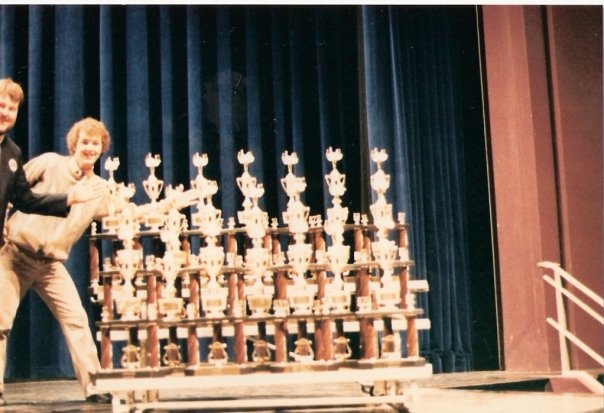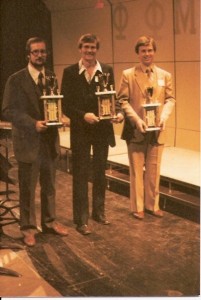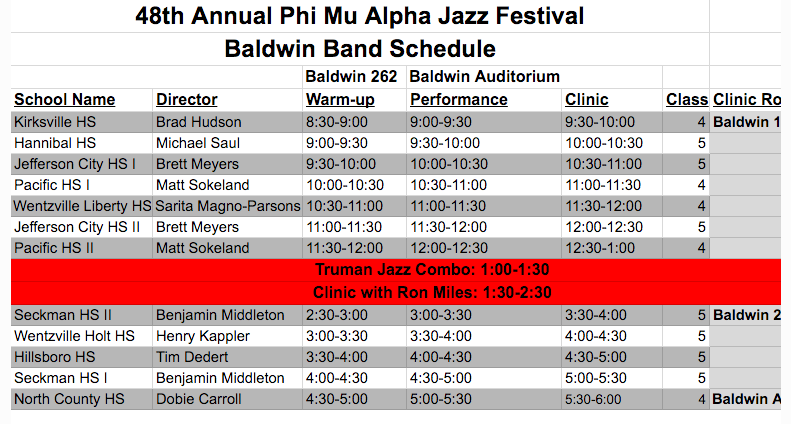The day starts early for the visiting high schools and middle schools and even earlier for the brothers of PMA. Active members serve as liaisons for the visiting schools, guiding bands around campus from their homeroom, to the performance area, to their specialized clinic.
Competitive Beginnings
For years, JazzFest was a competitive festival. Visiting bands were classified in divisions, performed for a panel of judges, then awarded trophies based on their performance. In the ’70s and ’80s, the model was like a marching band festival. As AuBuchon puts it, they were “very competitive, big trophies, blood bath with your neighboring school.” In his view, the competitive nature of these festivals is only fun when you’re doing well.
[When I was in high school] you didn’t get a clinic so much. Sometimes you did, but a lot of times you would have a half-hour slot and you would play 20 minutes then the judge would run up and try to do a quick something like, “You! Who’s your favorite alto sax player” “Uhhh…” “Yeah! You need to listen more, kid! And how about you? Favorite trombonist!” “Uhhh…” “You should have said J. J. Johnson. You guys need to listen more! Okay I’m out of time.” …Of course I was, by then, a little jazz geek so I’d say, “Phil Woods is my favorite alto sax player” and they’d go “[nods head, impressed. Moving on to next kid] Who’s your favorite trombonist?” “Uhhh…” And it’s (hesitant) truuue, but not very useful. You do need to listen a lot [but that isn’t everything]. But that’s how I remember it. There are certainly exceptions and good clinics, but I don’t remember it that way. And there’s still some festivals like that where I’ll go judge and you don’t get to do a clinic. I just sit there and tape comments and I hope it gets to people. And sometimes I’ll have a director say, “I always appreciate your comments, I read them to the band” and the good directors are going to use that, but it’s a little more work. So directors who don’t care so much aren’t going to learn anything if you don’t have a really good clinic—but the kids might at least.
–Prof. Tim AuBuchon on his experiences with jazz festivals in high school
For many universities, especially those in larger or more accessible cities, this is still the case. But this all changed when AuBuchon took over as the jazz director.
[W]hat I started doing was the competition still, but we would do the full-length clinic. The same amount of time you spend on the performance, you get a clinic. And I’ve talked to another one of my friends at another university in Omaha and he has sort of a similar set-up. He’s been there a couple years longer than me and he’s gone through the exact same evolution of the festival. When I talked to him about it, I said, “I’m thinking about going non-competitive” and he said, “Oh yeah, we did that a couple years ago and it’s been great ever since.” No one complained, it’s less pressure. Because if something is messed up, and it’s noncompetitive, they tend to be a lot more understanding. They say, “Oh it’s fine. It’s been great anyway.” But boy, if there’s something that’s an issue with them where they should have won and they didn’t, or they feel like that’s the case—and we always try to be very careful of that—but invariably, there’s something funny that gets someone really mad, they’re really stressed out. And it’s just—I don’t care for it.
While he makes a point of saying that he is “not totally philosophically opposed” to the traditional types of competition, he places a bigger emphasis on the educational aspect of the festival and stresses the value of the clinics over the competition for this particular festival.
Even though the festival is not competitive anymore, the visiting bands will get “Outstanding Musicianship” certificates and “Outstanding Soloist” awards. This way, any and all exceptional musicians can be recognized for their performances, without having to compete against other performers.
Getting the Word Out
When asked about the advertisement and recruitment process and how get schools to participate, AuBuchon remarked,
A lot of [the schools] just historically end up being the same ones that come to [this festival]. I do try to reach out to directors and sometimes that works and sometimes it doesn’t. Sometimes they just don’t have the money or are busy at one of these other [festivals] they are committed to. Certain directors will cycle around so we know they won’t come here every year because they like to go to the other ones, but at the same time we know that they will come back at some point. Some people get locked in one festival and they always do that one—if they’re Truman alums, of course, they tend to get locked in here, which is good. I don’t mind if they get locked in here so much; I don’t ever encourage them to try out other ones [laughs].
Though AuBuchon is, of course, joking with his last point, recent trends in attendance have raised concern among PMA members and organizers. Ryan Stains and Zach Green also brought up this point and note that TSU’s location in Northeast Missouri, a three hour drive from St. Louis or Kansas City, makes it an inconvenient and unappealing travel destination. A good year brings in about 25-30 bands, but in recent years, number have been in the mid to upper teens. As AuBuchon recalls,
My first year I think we had 28 or 29 schools. This year we have 21, which is actually better than it has been. It’s definitely been trending down where I felt good if we got about twenty because twenty is about the break-even financial point.
PMA is hopeful that JazzFest 50 will help revive the festival and attract more schools. They also hope to secure the financial support to be able to extend the guest artist’s residency an extra day or two or to book a musician or band with a higher profile.
Day 2–Saturday, February 27, 2016
I shadowed the chapter president, Ryan Staines, as he escorted the Hannibal, MO middle school jazz band around campus. The band consisted of about 15 students and was directed by Mr. Michael Saul.
Rehearsal
The bands had thirty minutes of rehearsal time, so Mr. Saul made sure to use every second of it. He helped the kids tune, gave an encouraging a pep talk, and ran through their short set in preparation for the judged performance. But before the band played a single note, Mr. Saul asked, “Why do we come to these festivals?” There was a brief moment of silence. A student raised her hand and responded, “To learn more about jazz music.” Mr. Saul was pleased with this response and continued, “Anyone else?” Another hesitant student answered, “Because they’re fun.” Mr. Saul smiled. “Anything else?” Finally, a third student replied, “To get feedback and critiques so we can become better musicians.” I saw a sincere sense of pride wash over Mr. Saul, who taught his students that festivals like JazzFest offer an opportunity to grow as a musician, to gain experience as a performer, and to have fun.
Their rehearsal sounded a little rough at first, but Mr. Saul was patient and worked out as much as he could before they had to leave again. After a final pep talk, the kids packed up and followed Ryan to the room where they performed for the judges.
Judged Performance
In a large rehearsal room, the kids set up again, this time in front a small audience of family and TSU students. Three judges sat in the back of the room and made notes on handheld recorders. Mr. Saul introduced his band, thanked the judges for their time, and kicked off the set. My attention was drawn to the drummer, who was exceptionally talented for his age. After two short tunes, the judges offered some preliminary constructive criticism that is neither too harsh nor too ‘nice.’ They also made a point to praise the drummer for anchoring the band. The students were refreshingly receptive and most seemed genuinely interested in what the judges had to say about their performance.
Clinic
There was a ten-minute gap between the performance and the clinic in the adjacent room. The kids talked while the judges continued to document their thoughts on the performance, which are later given to the band director to relay to his or her students.
At last, the band filed into the neighboring room and prepared for their specialized clinic with one of the judges, Dr. Michael Shults (assistant music professor at the University of Wisconsin). Dr. Shults looked to be no older than thirty, but spoke with the confidence of a more seasoned musician. He had his saxophone with him, which he played only to illustrate points that may not have been clear to the students. Like Miles, he was as strong of an educator as a musician. Though the kids were roughly 13-14 years old, Dr. Shults spoke to them like he would to his own students, never dumbing anything down, but also avoiding complicated jargon. In fact, his approach raised them up to the level of professional musicians, and he treated them as accordingly without being patronizing.
He offered specific notes on their set and had them run through a few bars. Most of the time, his comments were directed at a specific section of the band, but occasionally he would give individual feedback. Once again, he commended the drummer and challenged him to play some more complex rhythms. Dr. Shults encouraged him to play “too much” (for now), so they could both get a sense of what he was capable of, then tone it down as necessary.
Mr. Saul sat off on the side, observing. He seemed so proud of his students when they applied the advanced techniques Dr. Shults was teaching them. Perhaps most exciting, especially for Mr. Saul, was that you could see and hear the students learn and grow as musicians. At least with this band, JazzFest had achieved its goals.



